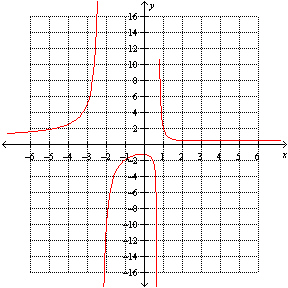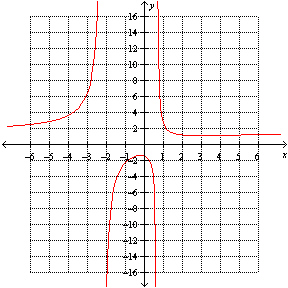A) ![]()
B) ![]()
C) ![]()
D) ![]()
E) ![]()
Correct Answer

verified
Correct Answer
verified
Multiple Choice
The graph of a rational function is given. Determine the equation(s) of the vertical asymptote(s) . 
A) ![]()
![]() and
and ![]()
![]()
B) ![]()
C) ![]()
D) ![]()
![]() and
and ![]()
![]()
E) There are no vertical asymptotes.
Correct Answer

verified
Correct Answer
verified
Multiple Choice
Suppose that  is inversely proportional to the square of
is inversely proportional to the square of  . Which one of the following is an equation that expresses this statement?
. Which one of the following is an equation that expresses this statement?
A) ![]()
B) ![]()
C) ![]()
D) ![]()
E) ![]()
Correct Answer

verified
Correct Answer
verified
Multiple Choice
The function  is graphed below. Determine the x - and y -intercepts.
is graphed below. Determine the x - and y -intercepts. 
A) The x -intercept is ![]() ; the y -intercept is
; the y -intercept is ![]() .
.
B) There are no x -intercepts; the y -intercept is (0, ![]() ) .
) .
C) There are no x -intercepts; there is no y -intercept.
D) The x -intercept is (0, ![]() ) ; there is no y -intercept.
) ; there is no y -intercept.
E) The x -intercepts are (0, ![]() ) and (0,
) and (0, ![]() ) ; the y -intercept is (0,
) ; the y -intercept is (0, ![]() ) .
) .
Correct Answer

verified
Correct Answer
verified
Multiple Choice
Determine the end behavior of the function  .
.
A) As ![]() and as
and as ![]() .
.
B) As ![]() and as
and as ![]() .
.
C) As ![]() and as
and as ![]() .
.
D) As ![]() and as
and as ![]() .
.
E) As ![]() and as
and as ![]() .
.
Correct Answer

verified
Correct Answer
verified
Multiple Choice
The area of a circle with radius  is given by the power function
is given by the power function  . What happens to the area of the circle when the radius is multiplied by 3?
. What happens to the area of the circle when the radius is multiplied by 3?
A) The area increases by a factor of 9.
B) The area is also multiplied by 3.
C) The area increases by ![]() .
.
D) Not enough information.
E) The area increases by ![]() .
.
Correct Answer

verified
Correct Answer
verified
Multiple Choice
Determine the end behavior of the function  as
as  .
.
A) As ![]() .
.
B) As ![]() .
.
C) As ![]() .
.
D) As ![]() .
.
E) As ![]() .
.
Correct Answer

verified
Correct Answer
verified
Multiple Choice
Express the polynomial function  in complete factored form.
in complete factored form.
A) ![]()
B) ![]()
C) ![]()
D) ![]()
E) ![]()
Correct Answer

verified
Correct Answer
verified
Multiple Choice
Which one of the following is the graph of  .
.
A) ![]()
B) ![]()
C) None of these options
D) ![]()
E) ![]()
Correct Answer

verified
Correct Answer
verified
Multiple Choice
Which one of the following is the equation of the horizontal asymptote for  ?
?
A) ![]()
B) ![]()
C) ![]()
D) ![]()
E) ![]()
Correct Answer

verified
Correct Answer
verified
Multiple Choice
Which one of the following graphs represents the function  ?
?
A) ![]()
B) ![]()
C) ![]()
D) ![]()
E) ![]()
Correct Answer

verified
Correct Answer
verified
True/False
If the rational function  has the vertical asymptote
has the vertical asymptote  , then as
, then as  ,
,  also.
also.
Correct Answer

verified
Correct Answer
verified
Multiple Choice
Find the equation of the horizontal asymptote of  .
.
A) ![]()
![]()
B) ![]() 3
3
C) ![]()
![]()
D) ![]()
![]()
E) ![]()
![]()
Correct Answer

verified
Correct Answer
verified
Multiple Choice
Determine the end behavior of the function  .
.
A) As ![]() and
and ![]() .
.
B) As ![]() and
and ![]() .
.
C) As ![]() and
and ![]() .
.
D) As ![]() and
and ![]() .
.
E) As ![]() and
and ![]() .
.
Correct Answer

verified
Correct Answer
verified
Multiple Choice
Which one of the following graphs represents the function  ?
?
A) ![]()
B) ![]()
C) ![]()
D) ![]()
E) None of these options
Correct Answer

verified
Correct Answer
verified
True/False
For values of  , the function
, the function  grows faster than the function
grows faster than the function  .
.
Correct Answer

verified
Correct Answer
verified
Multiple Choice
Which one of the following is a graph of the function  ?
?
A) ![]()
B) ![]()
C) None of these options
D) ![]()
E) ![]()
Correct Answer

verified
Correct Answer
verified
Multiple Choice
Determine the behavior of  as
as  .
.
A) As ![]() .
.
B) As ![]() .
.
C) As ![]() .
.
D) As ![]() .
.
E) As ![]() .
.
Correct Answer

verified
Correct Answer
verified
Multiple Choice
Determine the end behavior of the function  .
.
A) As ![]() and as
and as ![]() .
.
B) As ![]() and as
and as ![]() .
.
C) As ![]() and as
and as ![]() .
.
D) As ![]() and as
and as ![]() .
.
E) As ![]() and as
and as ![]() .
.
Correct Answer

verified
Correct Answer
verified
Multiple Choice
A cardboard box has a square base, with each edge of the base having length  inches, as shown in the figure. The volume of the box is determined by the function
inches, as shown in the figure. The volume of the box is determined by the function  . What is the domain of
. What is the domain of  in the context of this problem?
in the context of this problem? 
A) ![]()
B) ![]()
C) ![]()
D) ![]()
E) ![]()
Correct Answer

verified
Correct Answer
verified
Showing 21 - 40 of 71
Related Exams